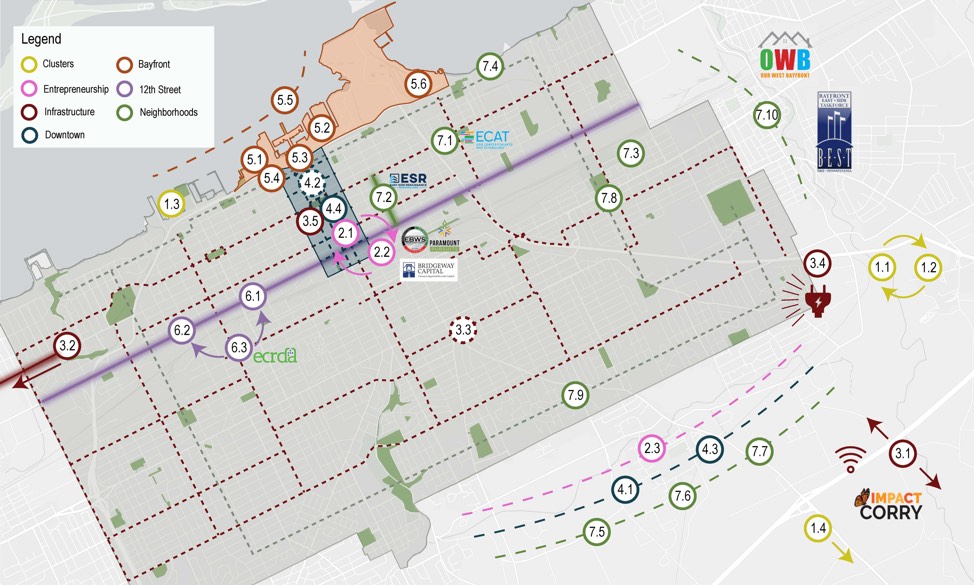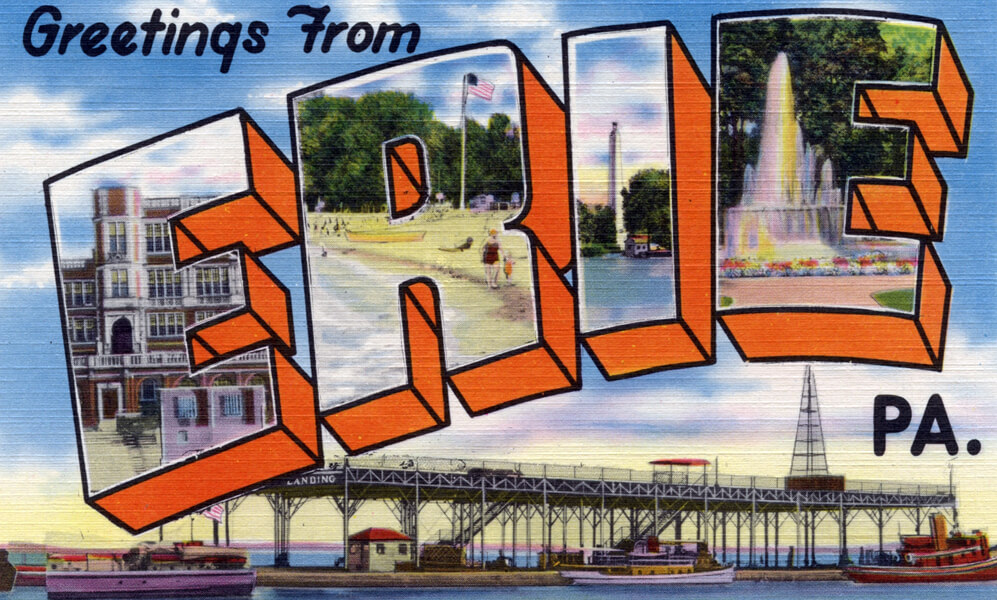Erie, Pennsylvania is on a roll. Like many communities in the Midwest, this city and county experienced the harsh effects of deindustrialization, decline and disinvestment. Over the past decade, however, a group of dedicated local government, corporate, university and civic leaders, spurred by Erie Insurance Company’s growth and investment, has begun to build the city back.
There is no better evidence of this fact than a substantial recent development: today, Erie has one of the most ambitious Investment Playbooks in the country and a bold new governance model to ensure its sound implementation.
Even in a swing county within a swing state, Erie is proof that bipartisan, substantive progress towards local equitable growth is possible.
Many of Erie’s recent efforts have focused on leveraging the urban core. Despite decades of gloom and doom, Erie has several distinctive advantages for its size and industrial heritage, starting with the incomparably beautiful Lake Erie and Presque Isle State Park. Anchor institutions like Gannon University, UPMC-Hamot and the Erie Insurance Company are also concentrated in the historic downtown, giving this small geography an enviable level of employment density. The downtown is going through a substantial makeover, spurred by the creation and capitalization of the Erie Downtown Development Corporation (the “EDDC”) and the strategic deployment of Opportunity Zone investments.
This progress has formed a strong platform for the next burst of collaborative action. Buoyed by these recent successes, leaders in Erie are again making a substantial bet on the city and county’s future. Last week, a network of public, private and civic institutions released the country’s latest Investment Playbook, entitled “Erie’s Inclusive Growth: A Framework for Action.”
Erie’s Investment Playbook identifies 35 concrete, priority projects, identified through discussions with local stakeholders. The projects are ambitious and go beyond simple uses of federal funds: they range from scaling the acquisition and renovation of single-family homes to completing mixed use developments in the Bayfront to accelerating the remediation of polluted industrial properties. The Playbook places equity front-and-center, prioritizing support for Black- and Brown-owned small businesses, first-time and minority homeowners, and local suppliers.
There are projects that focus on specific places (e.g., the central business district, the waterfront, adjoining residential neighborhoods, and a nearby industrial corridor) as well as projects that cut across the city and county (e.g., infrastructure, entrepreneurship, and business clusters). The spatial distribution of the projects is shown below:

While some of these projects are “shovel ready,” with well-defined costs and stakeholders ready to take the lead, others require some planning (for example, the Playbook recommends that Erie expand the continuum of care for those individuals and families experiencing homelessness). For each of these still “exploratory” projects, as described below, a local delivery team is being identified and tasked with sharpening the design of projects within a specified time period.
Erie is the latest city to use the Investment Playbook tool, co-created by New Localism Associates and the Nowak Metro Finance Lab at Drexel University, to take full advantage of federal resources in specific geographies. A formal Investment Playbook has also been created for the downtown of Dayton, Ohio, a health innovation corridor in El Paso and disadvantaged commercial corridors in Buffalo, Greensboro, N.C., Philadelphia and Pittsburgh. An effort to create an Investment Playbook for downtown San Bernadino is also underway, in close collaboration with the Aspen Institute’s Latinos and Society Program.
Investment Playbooks respond to the reality that the federal government is investing trillions of dollars across hundreds of programs and dozens of agencies. These resources are unprecedented and much needed. But the fire hose of funding will only have transformative effect if cities actually have real projects that (a) are concrete and costed out; (b) can leverage other public, private and civic capital; and (c) can be layered and aligned with other worthwhile projects. U.S. cities have learned the hard way that transformative visions without capital specifics drive conversation, not investment.
While federal resources may be ample, only localities can design specific projects that are fit to place, ripe for investment and come together for cumulative impact.
Erie’s Investment Playbook is distinctive on several levels
First, Erie’s Investment Playbook is the first to include funding made available under the Infrastructure Investment & Jobs Act. The layering of transportation, energy and broadband projects in small geographies (e.g., waterfronts, downtowns) shows the potential for alignment and coordination that is often extolled at the federal level but is only possible when funding actually hits the ground.
Second, Erie is the first place to create a special governance vehicle to ensure that projects actually get financed and delivered. Erie leaders have created a new “Nerve Center” that is driven and overseen by Mayor Joe Schember, County Executive Brenton Davis and representatives from the Erie Community Foundation, Erie Insurance, the Erie Regional Chamber & Growth Partnership, the Jefferson Educational Society, the Erie County Gaming Revenue Authority, and the Erie County DEI Commission.
This is an unlikely and remarkable coalition. While the newly elected Republican County Executive and the Democratic Mayor don’t agree on all policy issues, they are closely aligned on the work of the Nerve Center. In this way, Erie is showing remarkable collaboration across sectors and across parties. Even in a swing county within a swing state, Erie is proof that bipartisan, substantive progress towards local equitable growth is possible.
While federal resources may be ample, only localities can design specific projects that are fit to place, ripe for investment and come together for cumulative impact.
The day-to-day work of the Nerve Center will be headed by Kim Thomas, who formerly worked with the Commonwealth of Pennsylvania’s Department of Community and Economic Development and has the perfect skill set for the job. Specifically, Kim and the Nerve Center are now tasked with:
- Deploying Delivery Teams and refining the Playbook: For example, the Nerve Center is working with multiple neighborhood organizations to create an integrated plan to accelerate home renovations and home ownership.
- Matching local projects to federal, state, and philanthropic capital: For example, the Nerve Center is exploring unique funding mechanisms for brownfield projects (e.g., sinking funds) and helping the local development corporation (EDDC) explore a second fund to invest in developments downtown.
- Ensuring ongoing collaboration: For example, the Nerve Center will convene the City Planning Office, utility providers, and local investors to ensure each entity is jointly working toward an improved grid structure for the downtown.
Finally, Erie understands full well that the Investment Playbook will require smart local investment. The creation of EDDC and the Erie Preservation Trust and the deployment of Opportunity Zone capital have already shown an unusual commitment of local investors to invest back in their home city rather than export capital to other parts of the country. With strategic investments of local capital in the Investment Playbook, Erie knows it can leverage an amount of funding many orders of magnitude larger that can be put to work for the city and county.
Erie’s public, private and civic leaders and institutions exemplify the radical collaboration that is needed to build back better in the aftermath of the pandemic. They are coming together to do big things in a small city.
Bruce Katz is the Founder of New Localism Associates; Florian Schalliol is a Project Director with New Localism Associates.
![]() MORE FROM THE CITIZEN’S SERIES THE VIRUS AND THE CITY
MORE FROM THE CITIZEN’S SERIES THE VIRUS AND THE CITY
MOST POPULAR NEWS ON THE CITIZEN RIGHT NOW



